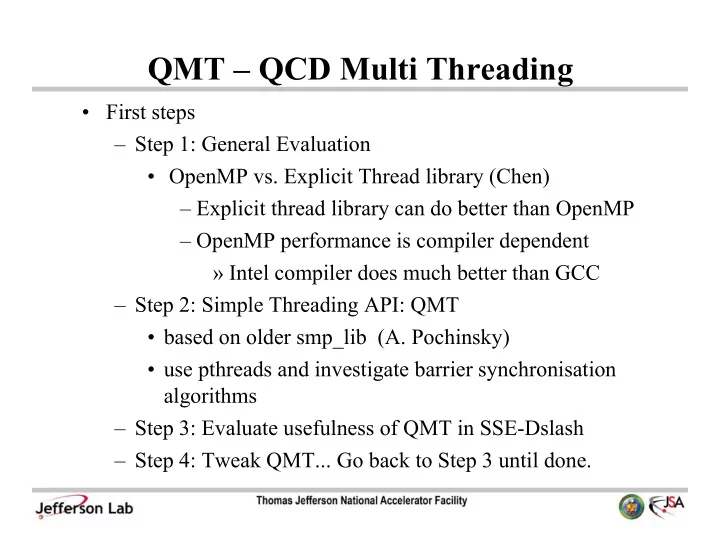

QMT – QCD Multi Threading • First steps – Step 1: General Evaluation • OpenMP vs. Explicit Thread library (Chen) – Explicit thread library can do better than OpenMP – OpenMP performance is compiler dependent » Intel compiler does much better than GCC – Step 2: Simple Threading API: QMT • based on older smp_lib (A. Pochinsky) • use pthreads and investigate barrier synchronisation algorithms – Step 3: Evaluate usefulness of QMT in SSE-Dslash – Step 4: Tweak QMT... Go back to Step 3 until done.
QMT – Basic Threading Model initialize / thread fork • 1 Master Thread & several slave Thread #1 threads spawned when calling Thread #0 (Slave) (Master) qmt_init() Serial Idle • Node- Serial part of code runs in Code master thread – while slaves sit idle. • Node-Parallel parts of code run in Parallel Parallel master and slave threads sites 0..7 sites 8..15 – Data parallel: All threads execute same function on different data. barrier sync – Data blocks described in terms of first & last site of block. • Slave threads destroyed by calling qmt_finalize(); finalize / thread join
Dslash • Implemented (re-enabled) threading in SSE Dslash • Tested on Dual Socket, Dual Core (4 cores in total) Opteron, 64 bit linux. • Compare 4 threads in 1 MPI process vs 4 MPI processes communicating through memory. Global Volume Threaded Performance MPI Performance Threaded/MPI (sites) Mflops (4 threads) Mflops (4 processes) (gain in favour of threads) 2x2x2x2 1258 1560 0.81 4x4x4x4 6572 6595 1 4x4x8x8 8120 7597 1.07 8x8x8x8 7929 8108 0.98 10x10x8x8 6668 5338 1.25 12x12x12x12 2465 2280 1.08 12x12x24x24 2340 2264 1.03 • On the whole threading seems to help some • But not a lot... Can we do better?
Future Improvements • Increase access to local vs remote memory – eg: interleave memory allocation between processors (libnuma • If there are leftover cores, but memory bandwidth is exhausted – use core for something else (comms coprocessor, heater etc) – need to tweak API. • Improvements likely to be architecture specific, depending on things such as – systems libraries and facilities (eg: libnuma) – actual node architecture • hardware memory strategies (number of controllers, available bandwidth), shared caches & coherency etc. • Grand Unified Threading Interface will be challenging...
Chroma on BG/L with BAGEL Dslash 1.4.6 • BU BG/L & MIT BG/L – all regressions pass, some 1024 core tests fail at MIT - following up on this to determine cause of problems. • Dslash Performance (BU BG/L) – single node, single core, Vol=4x4x8x8 • Double Prec: 1328 Mflops/core (47% of peak) • Sloppy (single internal) Prec: 1521 Mflops/core (54% of peak) – 512 node, 1024 core, Local Vol =4x4x8x8, CPU Grid=8x8x8x2 • Double Prec: 696 Mflops/core (24.8% of peak) • Sloppy Prec: 869 Mflops/core (31.1% of peak) • Clover Inversion – in (R)HMC, 512 nodes, 1024 cores, vol=16x16x16x64, subgrid= 8x2x2x8 , cpu grid=2x8x8x8, Sloppy Prec, (BU BG/L) – Chroma Level 2 CG: 312 Mflops/core (11% of peak) – Chroma Level 2 Multi Shift CG (9 poles): 294 Mflops/core (10.5%) • Need to try native QMP or QMP-MPI-2-1-7, track problem on MIT machine convert QDP_BLAS for double hummer if not done already.
Recommend
More recommend